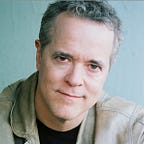“After On” Audio Series: Episode 4 of 8
Audiocast: Synthetic Biology: Our Salvation or Annihilation?
They call it the Carlson Curve. Much as Moore’s Law traces improvement in the digital realm, it tracks our lengthening baby steps in synthetic biology. Consider the Human Genome Project. The bioinformatics elite needed thirteen years and three billion dollars to read out a single human genome. Less than a decade and a half on, a lone lab tech can do this in just hours. That’s the Carlson Curve. And it makes the price/performance swan dive of Moore’s Law look like a bunny slope.
The fourth audio episode connected to my novel After On features an extended rumination on all of this with Andy Hessel. It’s about 75 minutes long, and is embedded at the top of this page. Andy is the prime instigator of “GP-Write” — a program that many describe as the Human Genome Project’s heir. He and I discuss how radical cost improvements in gene sequencing — which is a fancy way of saying “gene reading” — might soon be replicated in the act of writing, or synthesizing DNA.
Andy recounts how it cost up to $20 to write a single base pair of genetic code back in 2000. Today, this’ll run you about a dime. And prices are plummeting. By 2026, it’ll cost maybe $10 million to synthesize an entire human genome. Not a consumer price-point to be sure — but within the budgets of untold thousands of workgroups and organizations.
Today, Harvard’s George Church might be the sole person capable of casting certain biological spells. But this will change as we rocket down the Carlson Curve. Just as nuclear proliferation delivers Manhattan Project capabilities to failing states, the Carlson Curve will one day have high school biology classes doing things Mr. Church can only dream of. And then what?
Andy Hessel is optimistic. And thank God for that, because he knows this stuff cold. Although — hmm. It could just be the science fiction writer in me. But I do worry about keeping millions of freshman bio students off the dark path to Columbine 2.0. Ditto the aspiring cult leaders, the nihilistic terror cells, and anyone whose final act is slaughtering as many fellow humans as possible. That’s hundreds of people a year in the US alone. Should their weapons get boundlessly nastier than mere guns, we cannot have hundreds of incidents a year. We can’t have dozens. We can’t have any. Perfect outcomes are notorious difficult to attain. But this is a case in which 99.9% is nowhere near good enough.
Luckily, there’s also so much to be excited about in the realm of synthetic biology, and Andy and I spend most of our time discussing the positives. Amazing therapies, products, and breathtaking creations lie down this path. I also sincerely believe that cancer’s days are numbered.
This is the third audio episode I’m previewing to Medium members. I’ll publish five more between now and the end of August. After previewing on Medium, each episode will be pushed out to the rest of the world as a weekly podcast series, starting August 1st (the novel’s publication date).
Though these episodes are meant to add context to After On, I should note that it’s NOT necessary to read the novel in order to listen to and learn from them. Significant discussion of the book is delayed until the very last section of the episode, when my cohost (Tom Merritt) and I do relate the interview to the storyline. If you’re not reading After On (or if you are reading it, but haven’t caught up t to the section we’re discussing that week) you can just tune out then.
